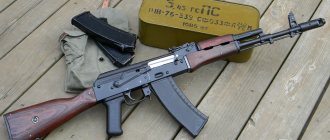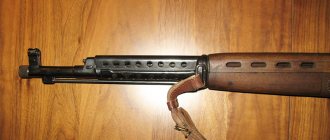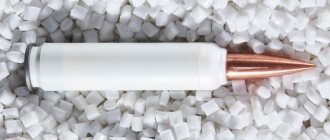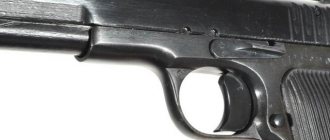Why do you need a DTK on a bolt carbine? To reduce recoil) This is important not only to protect your shoulder, but also to be able not to lose sight of the target, and to see where the bullet came in order to make adjustments if necessary. When I took tuning for a carbine, it came with a DTK kit. With him, as you remember, I started working on this complex. It fit well on the first barrel, but for some reason the thread of the second turned out to be weaker, and the screws for fixing the DTK had to be tightened with indecent force (more than 7 nm). This, of course, is not very good - after all, this is essentially pressure on the muzzle, where the barrel is already weakened by the threads. And the place for accuracy is critical) Therefore, I was puzzled by the change of DTK and arranged a small casting)
Of course, of all the options, you want the most effective one. By efficiency here we will mean maximum recoil damping compared to a shot without a muzzle device.
Above you can see the characteristic operation of the DTK compared to the case when there is only a protective nut on the thread. I think comments are unnecessary.
In total, 4 DTK took part in the test under 7.62/.30, 18x1 thread, plus control shooting without devices, and with DTKP (can) out of competition, just to understand how this device is capable of changing the recoil force. Tests were carried out at Test Site #1.
For testing, a table with a smooth surface was taken. Of all the available means, the combination of a mat for the bipod and a bag for the handle showed minimal friction with the table surface in combination with stability. In this case, however, there was a slight downward tilt of the barrel, so in order for the recoil force to be directed horizontally, this was compensated for by installing the table at a slight angle.
When shooting, each time the muzzle was uniformly positioned relative to the edge of the table using a plumb line.
A scale was placed on the table that made it possible to measure the length of the rifle's run during recoil.
The rifle's travel length was uniformly measured at the point where the barrel meets the thread. A level was used for measurement to reduce measurement errors. For the same purpose, 4 shots/measurements were made for each device.
Shooting with an analogue of DTK APA LB from DTK NSK
The third shooting was already with one of the tested DTK. Structurally, this is an analogue of the Little Bastard DTK from American Precision Arms.
The weight of this DTK is 135g, the through hole is 8.97mm. This is the most compact device of the entire test. I also really liked the locking system. The DTK comes with a lock nut, which needs to be adjusted once so that when tightened by hand, the DTK gets into the correct position. Then we “remember” the setting with blue thread locker, and voila. Maximum convenient removal/installation of the device, and no squeezing.
The average result for four measurements for the APA LB analogue from DTK NSK was 112 mm. Of course, it’s very contrasting, if you remember the results shown without devices (260mm) or with a can (217mm).
Principle of operation
The device is based on the principle of changing the speed and direction of movement of powder gases, which are released during the combustion of the main charge of a cartridge or projectile. The speed of their spread is very high - up to 1500 m/sec. This causes a force that is directly opposite to the direction the bullet is traveling. The muzzle brake effectively dampens this impulse. In this case, part of the resulting powder gases is used. Therefore, such devices are more profitable, since they do not deteriorate the ballistics of the weapon; in addition, they are reliable and simple in structure. Their main areas of application are pistols, assault rifles and artillery pieces.
Shooting with DTK from CUSTOM GUNS
Structurally, it is difficult for me to attribute this DTK to any foreign or domestic analogues. In appearance there are similarities with both Vertebrae and Roedale. So it looks like this is an independent development of the company.
The weight of this dtk was 129g, the through hole was 8.49mm. The mount is interesting. The thread does not start from the edge of the dtk, but somewhat deeper. This required certain adjustments when positioning the carbine and taking into account the results, since in other cases the boundary of the barrel and thread was used as a mark.
I really liked this design solution. The fact is that in other similar DTKs, fixation with screws leads to the fact that the force is concentrated on the thread, where the barrel is already weakened. In addition, this is where it is most critical for accuracy - in the case of a large tightening force, the bullet exit can be compressed. This solution uses a thicker part of the barrel for fixation. However, it also has disadvantages.
With this design, the DTK must be selected not only for a specific thread, but also for a specific barrel thickness. In my case, it turned out that the thickness of the barrel was not enough to fix the DTK. This is clearly visible in the video. It was possible to carry out the test; this will not affect recoil damping. But it’s impossible to shoot for accuracy with such “play.” It would be very cool if Custom Guns used for this DTK the same fastening with a lock nut that we saw on the APA LB analogue from DTK NSK. This would be as convenient as possible.
The average result across four measurements for the Custom Guns DTK was 98mm.
Legality of closed type DTK Rotor 43
The very first question that is most often asked about our closed-type DTKs is the question of the legality of their installation on weapons. We have already answered in detail the question of the legality of installing a closed-type DTK on a weapon in a special material on this topic. Here we will only briefly recall that the installation of a closed-type DTK produced by Rotor 43 on a weapon does not contradict the law, since it is just a DTK, and not a PBS, which has long been confirmed by an official expert opinion; a notarized copy of this expert opinion is included with each DTK Rotor 43. We work strictly officially and do not offer any illegal schemes to our customers. By installing a closed-type DTK manufactured by Rotor 43 on a weapon, you do not violate the laws of the Russian Federation.
Shooting with an analogue of the Roedale DTK from GUNFIT
Structurally, this DTK is a variation on the theme of the well-known Roedale DTK.
This is the lightest DTK in the test! Total 115g. Through hole 9.10mm. I was pleased with the very tight fit on the thread. The required screw tightening force for reliable fixation was minimal.
All DTKs fixed by tightening screws were installed using a level.
The average result for four measurements for the analogue of the Roedale DTK from GunFit was 113mm. This is only 1 mm more than the analog APA FB from DTK NSK. Taking into account measurement errors, the results of the DTC data can be considered virtually equivalent.
What is a muzzle brake compensator?
When firing any firearm, recoil is inevitable. It is caused by gas pressure in the barrel and the movement of automatic mechanisms in preparation for the next shot. The impact of recoil on such parameters as shooting accuracy, aiming and ease of control is very large. Many designers have tried to minimize weapon toss and recoil. With the advent of automatic weapons, this issue has become even more relevant. It was then that the first DTK (muzzle brake-compensator) appeared. They belong to the category of muzzle gas devices.
Shooting with an analogue of the Roedale DTK from mechsolver
Structurally, this DTK is a variation on the theme of the well-known Roedale DTK, like the previous model.
The weight of this dtk was 151g, the passage hole was 9.25mm. This is the heaviest device of all in this test. It is worth noting that, as I already mentioned, he is also the oldest in this company. I shot about 3,000 on the first barrel, and burned about 2,000 more on the second. By the way, despite the heavy shooting, the aluminum and gills are generally intact. The passage hole is decorated with a steel sleeve.
The average result for four measurements for the analogue of the Roedale DTK from mechsolver was 115mm. This is also very close to the previous test.
Varieties
DTCs are classified according to several criteria. These are the number of chambers (tubeless, single and multi-chamber), the number of side openings (single and multi-row) and the shape (window, mesh and slotted). There is also a classification according to the principle of action - reactive, active or active-reactive.
Active action involves the impact of a stream of gases on a certain surface that is attached to the barrel. In this case, a force arises opposite to the direction of recoil.
The reactive action involves the symmetrical removal of the used powder gases in the direction of recoil. After this, a reaction occurs, which is called “outflow of powder gas,” and the weapon receives an impulse that pushes it forward.
Proactive-reactive action combines both principles in one design so that the gas is first expelled forward and then retracted in the opposite direction to dampen recoil.
Summarizing
Let's see how all 4 tested DTKs performed in comparison with control tests.
We see a huge difference in recoil between shooting with the safety nut and using the DTK. The can reduced recoil, but was not nearly as effective as DTK. Three DTK showed similar results - from DTK NSK, GunFit, mechsolver. The best result was shown by DTK from Custom Guns.
Analyzing the results, I noticed one interesting pattern. It turned out that the smaller the passage hole, the better the result the DTK showed.
Structurally, this is quite logical. Reducing the passage opening allows you to redirect more gases, and therefore absorb more recoil, all other things being equal. However, other parameters were not equal - the DTKs had different sizes, different numbers of ports. As a result, the feeling was created that the type of DTK is not as critical as the through hole)))) That is, in essence, all designs are effective, but it is the through hole that sets the decisive point. It turns out that you can choose by design (for example, the presence of a lock nut like on the APA LB allows you to speed up installation), and simply ask to make it with a minimum throughput, and the DTK will be effective. I came to some conclusion for myself) It was also interesting to study different banks for the effectiveness of recoil damping. I have thoughts on what this depends on, maybe I’ll test it a little later)
Documents for products
That's right, we usually do not include documents (expertise) in the parcel, this is written on the card of each device. The fact is that it is enough to have the examination with you in electronic form; it is also presented in the card of each device in pdf format.
I downloaded the certificate on the page of the device intended for Saiga-12 / Vepr-12. Its description does not correspond to the actual one, in particular the diameter of the central hole, and other little things. I own an early version of the device. Please send me the correct certificate by email and correct the content of the page dedicated to your 12 gauge device.
The examination indicates the standard design of the device, taking into account its modularity and the possibility of manufacturing versions with lengths from 90 mm to 3000 mm in increments of 10 mm, with different outer diameters and bores, with the presence or absence of an influx part, it would be necessary to have approximately 9,000 different examinations.
Yes, we offer discounts for regular customers when placing second and subsequent orders. For now in manual mode (write), we will set it up automatically soon.
Yes, there will be a discount. You must send a scanned copy of your ID.
We have discounts for regular customers and existing employees; to apply the discount, you must provide your order number and attach a photo of a valid ID before paying.
Legal regulation of the issue
According to the third paragraph of the sixth article of the federal law “On Weapons,” citizens of the Russian Federation do not have the right to install devices for “silent shooting” on service or civilian weapons. Violation of this law is punishable by confiscation of the device, as well as a fine of 2,000 to 2,500 rubles. However, the most unpleasant thing is that such an offense can lead to the confiscation of a license to purchase weapons, as well as problems with re-obtaining the document.
But don’t rush to get upset, because in practice the state punishes few people for using silencers. The reason for this lies in the unclear wording of the Federal Law, as well as a huge number of holes, thanks to which the law can be circumvented. Firstly, not a single device in the world can lead to absolutely “silent shooting”. Secondly, only the use of silencers is prohibited, but no one limits their circulation. And thirdly, most of this “body kit” is classified as DTK, which has a “side effect” - eliminating the noise from the shot.
So how can you tell if your suppressor is banned? Unfortunately, only members of a special examination who will measure all the necessary characteristics can say this for sure. But even in this case, much will also depend on the bullet that the offender used for shooting (subsonic, transonic or supersonic). But in order not to make a mistake, it is best to buy a muffler that has been on the market for several years and has all the necessary documentation. But with a “homemade body kit” you should be careful.
Definition and purpose
A muzzle brake is a device that is intended for use in automatic small arms to reduce the recoil impulse when fired. Depending on the type of structure, the effective reduction rate ranges from 25 to 75%. Undesirable effects such as the sound of a shot, flames, and throwing the weapon up are also partially or completely suppressed. In general, this design is not mandatory, but often you simply cannot do without it. A classic example is the muzzle brake on the Vepr or AK-74.










